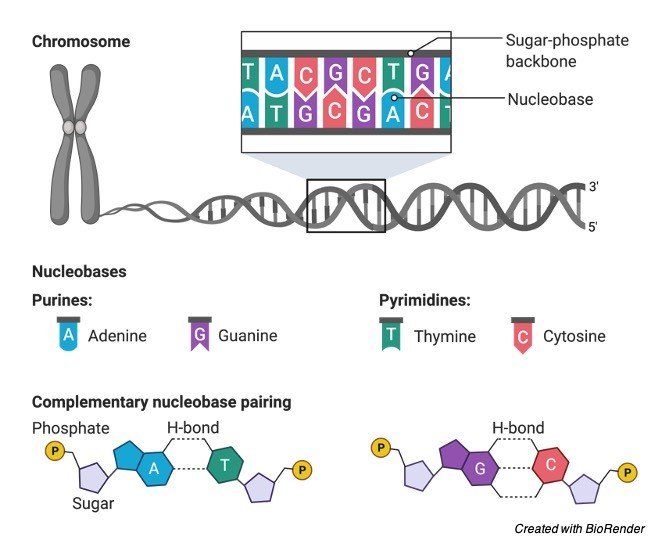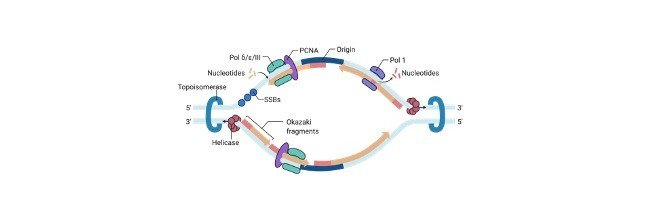What is DNA
It is defined as a long polymer that has a deoxyribose and phosphate foundation having 4 definite bases namely, thymine, adenine, cytosine and guanine.
It is primarily located in the nucleus of a cell and in the mitochondria.
It has 2 de-oxyriboses.
Its important function is to transmit genetic information to produce the various kinds of proteins and ultimately the whole body of the organism.
Thus, it acts like a extended storage.
The DNA is a double-stranded molecule that has an extended chain of nucleotides.
DNA can reproduce on its own, thus, known as self-replicating.
The base pair for the DNA is as follows;
• C:G :: Cytosine pairs with Guanine
• A:T :: Adenine pairs with Thymine
In cells, DNA (Deoxyribonucleic corrosive) is the nucleic acid that capacities as the first outline for the synthesis of proteins.
DNA contains the sugar deoxyribose, phosphates and a special sequence of the nitrogenous bases adenine (A), guanine (G), cytosine (C) and thymine (T).
The DNA molecules contain directions a living element needs to develop, create and imitate.
These directions are available inside every cell and are inherited from the parents to their offsprings.
It is comprised of nucleotides which contain nitrogenous group, a phosphate bunch, and a sugar group.
The request for the nitrogenous bases – thymine(T), guanine(G), cytosine(C), and adenine(A), is vital in deciding the hereditary code.
Genes are created by the order of the nitrogenous bases available in the DNA which is important for protein synthesis.
The RNA is another nucleic acid that translates hereditary data into proteins from DNA.

The nucleotides are connected together for the generation of two long strands which twist to create a structure known as the double-helix which takes after that of a ladder wherein the sugar and phosphate particles from the sides while the rungs are shaped by the bases.
The bases situated on one strand clubbed with the bases on the other strand, as in – guanine sets with cytosine and adenine sets with thymine.
The DNA molecule are extensively long and consequently without the right packaging, they can’t find a way into cells.
In this manner, DNA is firmly coiled to deliver developments alluded to as chromosomes. Each chromosome has a solitary DNA molecule. In human, there are 23 sets of chromosomes that are available inside the core of the cells.
Types of DNA
A-DNA
It is found at a humidity of 75%.
In a climate where there is a raised salt concentration or ionic concentrations, like K+, Na+, Cs+ or in a condition of dehydration it’s anything but a structure that contains 11 nucleotide pairs with a rise of 2.56Aº in an upward direction for each base pair.
It has the broadest helical diameter amongst all DNA structures – 23Aº DNA which is an ordinary helix that is right-handed with a rotation of 32.7º per base pair.
B-DNA
It is seen at a humidity of 9.25 and a low salt concentration or ionic strength. It has 10 base pairs for each turn which from the helix axis.
There is a distance of 3.4Aº with a helical width of 20Aº.
The Watson-Crick’s double helix model is characterized as a B-type of DNA.
C-DNA
It is seen at a humidity of 66% and in the inhabitance of a couple of ions like Lithium(Li+).
It intently has 9.33 base pairs for each turn.
The distance across the helix is about 19Aº and the upward ascents for each base pair for the right-handed helix is 3.32º.
D-DNA
It is noticed infrequently as an outrageous variation.
The 8 base pairs are tilted negatively from the helix axis with an axial rise of about 3.03Aº.
Z-DNA
It is found in a climate with an extremely high salt concentration. In contrast to the A, B, and C types of DNA, it is a left-handed helical structure.
The foundation is arranged in a crisscross shaped made up of the sugar-phosphate linkage wherein the recurrent monomer is the dinucleotide rather than the mononucleotide, which is seen in substitute structures.
RNA
It is defined as a polymer with a ribose and phosphate foundation with 4 diverse bases namely, uracil, cytocine, adenine and guanine.
It is usually found in the cytoplasm, nucleus and in the ribosome.
It has riboses. The RNA is a single-stranded molecule that has a miniature chain oof nucleotides.
RNA cannot reproduce on its own, it needs DNA to synthesize its molecule.
The base pair for the RNA is as follows;
• C:G :: Cytosine pairs with Guanine
• A:U :: Adenine pairs with Uracil
Ribonucleic corrosive (RNA) is a nucleic acid which is straightforwardly engaged with protein combination.
Ribonucleic acid is a significant nucleotide with long chains of nucleic corrosive present in every living cell.
Its primary job is to go about as a courier passing on guidelines from DNA for controlling the proteins synthesis.
RNA contains the sugar ribose, phosphates, and the nitrogenous bases adenine (A), guanine (G), cytosine (C), and uracil (U). DNA and RNA share the nitrogenous bases A, G, and C.
Thymine is normally just present in DNA and uracil is typically just present in RNA.
Types of RNA
Just a portion of the genes in cells are expressed into RNA.
Coming up next are the sorts of RNA wherein each type is encoded by its own kind of gene:
• tRNA: also known as the transfer RNA or the tRNA translate amino acids to ribosomes while translation.

• mRNA: also known as the messenger RNA or the mRNA encodes amino acid sequences of a polypeptide.
• rRNA: also known as the ribosomal RNA or the rRNA produces ribosomes with the ribosomal proteins that are organelles accountable for the translation of the mRNA.
• snRNA: The small nuclear RNA creates the complexes alongside proteins which are used in RNA processing in the eukaryotes.
DNA vs RNA Citations
- ABCs of DNA aptamer and related assay development. Biotechnol Adv . Mar-Apr 2017;35(2):275-301.
- The RNA World: molecular cooperation at the origins of life. Nat Rev Genet . 2015 Jan;16(1):7-17.
- RNA nucleotide methylation. Wiley Interdiscip Rev RNA . Sep-Oct 2011;2(5):611-31.
- DNA–DNA interactions. Curr Opin Struct Biol . 1998 Jun;8(3):309-13.
- The birth and development of the DNA theory of inheritance: sixty years since the discovery of the structure of DNA. J Genet . 2014 Apr;93(1):293-302.
- Disentangling DNA molecules. Phys Life Rev . 2016 Sep;18:118-134.
Share









